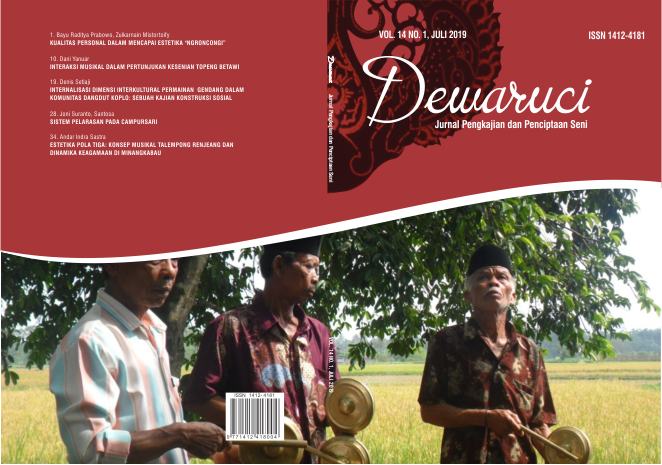Interaksi musikal dalam pertunjukan Kesenian Topeng Betawi
Main Article Content
Abstract
Penelitian ini membahas mengenai interaksi musikal dalam pertunjukan kesenian Topeng Betawi. Fokus permasalahan menitikberatkan tentang bagaimana jalinan interaksi musikal yang terjadi di antara para pemain musik dalam sajian gending pokok pertujukan kesenian Topeng Betawi. Metode yang digunakan dalam penelitian ini adalah deskriptif analisis yakni metode dengan cara menggambarkan atau melukiskan objek yang dikaji berdasarkan data-data yang diperoleh, yang kemudian dilakukan analisis terhadap data tersebut. Penelitian ini menerapkan teori interaksi musikal yang dirumuskan oleh Benjamin Brinner. Teknik pengumpulan data diperoleh melalui studi lapangan, perekaman audio-visual, dan studi pustaka. Hasil analisis dari penelitian ini dapat disimpulkan (1) Pemain rebab sebagai pimpinan yang memiliki kewajiban untuk mengkoordinasi jalannya pertunjukan. (2) Tata letak instrumen musik dari masing-masing penyaji didasarkan atas pertimbangan kelancaran pesan musikal. (3) Pesan musikal merupakan tanda yang kemudian mendapat respon dari pemain musik yang lain. (4) Struktur gending dipengaruhi jenis irama yang dimainkan. (5) Respon musikal merupakan wujud dari motivasi masing-masing pemain musik.
ABSTRACT
This study discusses the musical interaction in Topeng Betawi art performances. The focus of the problem focuses on how the fabric of musical interaction that occurs between the musicians in the musical staple grain Performace Topeng Betawi arts. The method used in this research is a descriptive analysis of the methods by describing or depicting an object under study based on the data obtained, which then conducted an analysis of the data. This research applies the theory of musical interaction formulated by Benjamin Brinner. Data collection techniques gained through fieldworks, audio-visual recording, and literature. Analytical results from this study can be concluded (1) Player fiddle as a leader who has the obligation to coordinate the course of the show. (2) The layout of musical instruments from each presenter is based on the consideration of the smoothness of the musical message. (3) Book musicals is a sign that later received a response from the other music players. (4) The structure of the musical influenced the type of rhythm being played. (5) Response musical is a form of motivation for each music player.
Downloads
Article Details
Authors who publish in Dewa Ruci: Jurnal Pengkajian dan Penciptaan Seni agree to the following terms:
- Authors retain copyright and grant the Dewa Ruci: Jurnal Pengkajian dan Penciptaan Seni right of first publication with the work simultaneously licensed under a Creative Commons Attribution License (CC BY-SA 4.0) that allows others to share (copy and redistribute the material in any medium or format) and adapt (remix, transform, and build upon the material) the work for any purpose, even commercially with an acknowledgment of the work's authorship and initial publication in Dewa Ruci: Jurnal Pengkajian dan Penciptaan Seni.
- Authors are able to enter into separate, additional contractual arrangements for the non-exclusive distribution of the journal's published version of the work (e.g., post it to an institutional repository or publish it in a book), with an acknowledgment of its initial publication in Dewa Ruci: Jurnal Pengkajian dan Penciptaan Seni.
- Authors are permitted and encouraged to post their work online (e.g., in institutional repositories or on their website) prior to and during the submission process, as it can lead to productive exchanges, as well as earlier and greater citation of published work (See The Effect of Open Access).
This work is licensed under a Creative Commons Attribution 4.0 International License
References
Brinner, Benjamin. Knowing Music, Making Music (Javanese Gemelan and the Theory of Musical Competence and Interaction. Chicago Art London: University of Chicago Press, 1995.
Koesoemadinata, R.M.A. Pangawikan Rinenggaswara. Djakarta: Noordhoff.Kolff N.V, 1950.
Ratna, Nyoman Kutha. Metodologi Penelitian Kajian Budaya dan Ilmu Humaniora pada Umumnya. Yogyakarta: Pustaka Pelajar, 2010.
Santosa. Komunikasi Seni: Aplikasi dalam Pertunjukan Gamelan. Surakarta: ISI Press, 2011.
Suparli, Lili. Peristilahan Karawitan Penelitian Dasar Diksi Karawitan Sunda. Bandung: Sunan Ambu STSI Press, 2008.
